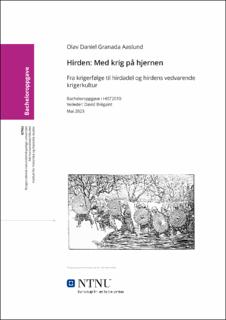| dc.description.abstract | Hirden var i flere århundrer en organisasjon med enorm betydning i det norske kongedømmet, og i denne lange perioden ville hirden være involvert i stort sett alt av krig i Norge. Hirden og hirdmenn representerte lenge kongedømmets profesjonelle elitestyrke, altså ryggraden av hæren, og ut ifra denne posisjonen ville deres organisasjon oppleve en gradvis og massiv vekst i både ansvar og innflytelse innenfor det norske kongedømmet. Hirdens senere historie, derimot, var en hovedsakelig fredelig periode med få muligheter for deltakelse i krig. Hirden i sin siste fase ville dermed ta for seg en større administrativ rolle i kongedømmet, ettersom kongedømmet ikke lenger hadde behov for krigere. Med tanke på dette, kan man stille seg selv spørsmålet, opplevde hirden en endring i deres militære funksjon og roller som følge av denne utviklingen?
Formålet med denne bacheloroppgaven er å analysere hirdens historie og utvikling, for å kunne se om hirden i sin siste fase lignet den tradisjonelle krigerhirden vi kjenner fra store deler av sin historie, altså en organisasjon med en hovedsakelig militærfunksjon og en dominerende krigerkultur. Oppgaven vil først presentere hirdens historie fra sen vikingtid til Håkon V’s død i 1319, hvor hirden opplever en gradvis utvikling til å bli en hirdadel av enorm innflytelse i det norske kongedømmet. Videre vil oppgaven i utgangspunktet fokusere på hirdens militære historie og kilder som gir innblikk i det militære aspektet av dets organisasjon. Ved dette vil oppgaven gi ett innblikk i hirdens historie som en organisasjon, og hvordan denne organisasjonen beholdt en hovedsakelig militær funksjon og rolle gjennom sin historie. | |
| dc.description.abstract | The Hird was for several centuries an organization of enormous importance within the Kingdom of Norway, and it would in this long period be involved in essentially all matter of war in Norway. The Hird and its “hirdmenn” represented, for a long time, the kingdom’s professional elite force, the “backbone of the army”, and from this position their organization would experience a gradual and massive growth in both responsibilities and influence within the Norwegian Kingdom. The Hird’s later history, on the other hand, was a mainly peaceful period with few opportunities for participation in war. The Hird in its final phase would thus take a bigger administrative role within the kingdom, as the kingdom no longer needed warriors. With this in mind, one could ask himself the question, would the Hird experience a change in its military function and purpose as a result of this development?
The objective of this thesis is to analyse the history and evolution of the Hird, so as to see if the Hird in its final phase resembled the traditional warrior-group we know from the majority of its history, i.e. an organization whose main purpose is to participate in warfare, and who also posses a strong and deeply rooted warrior culture. This paper will first present a general history of the Hird, from late Viking Age to King Håkon V’s death in 1319, where the Hird experience a long and gradual transformation, which result in them becoming the new powerful nobility of the Norwegian Kingdom. Thereafter, the paper will focus on the military history of the Hird, and primary sources which give an insight into the military aspect of its organization. With this, the paper will give an insight into the Hird’s history as an organization, and how this organization maintained a largely military function and purpose throughout its history. | |
